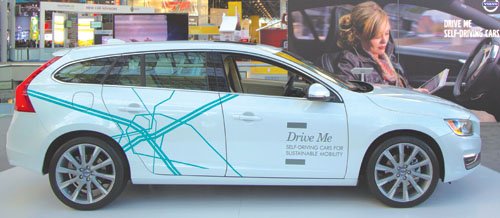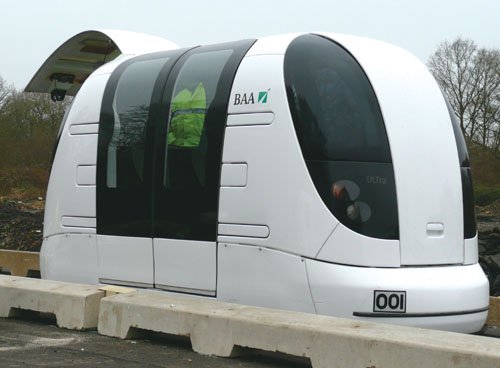 Automated or “self-driving” personal transport systems are no longer the preserve of science fiction. They are now up and running at several locations around the world. IEC (International Electrotechnical Commission, Switzerland) standardization work will prove instrumental in the expansion of systems that use innovative pod-type vehicles as well as for two-and three-wheeled “personal transporters”. Peter Feuilherade, Journalist and Consultant, the UK looks at how new personal modes of transport in urban areas can facilitate smart mobility
Automated or “self-driving” personal transport systems are no longer the preserve of science fiction. They are now up and running at several locations around the world. IEC (International Electrotechnical Commission, Switzerland) standardization work will prove instrumental in the expansion of systems that use innovative pod-type vehicles as well as for two-and three-wheeled “personal transporters”. Peter Feuilherade, Journalist and Consultant, the UK looks at how new personal modes of transport in urban areas can facilitate smart mobility
Personal, rapid, clean and safe
PRTs are small’ self-driving electric powered vehicles running on dedicated guideways and designed for on-demand use by individuals or small groups, typically four to six passengers, are often referred to as PRTs (personal rapid transit systems). PRTs are intended to combine the convenience and privacy of cars with the environmental benefits of mass transit. Their primary aims are to achieve optimum door to door mobility, improve safety, reduce environmental impact and lower operational costs. They are usually powered by onboard batteries recharged at stops, and guided by GPS (Global Positioning System) to destinations selected on touchscreens. Conventional steering can be used on a simple track consisting only of a road surface with some form of reference for the vehicle’s steering sensors.
The oldest system similar to a PRT has been in operation since 1975 in the US city of Morgantown, West Virginia. Comprising cars which hold about 20 passengers and run on a ground-mounted rail, it is more properly described as “Group Rapid Transit”.
Consumers would pay a fraction of the cost of buying and running an individual car, while building dedicated trackways would be much cheaper than the cost of most traditional transport infrastructure. The wider significance of driverless pod networks is that they are part of a long term trend in the car industry to develop autonomous vehicle control systems equipped with a combination of sensors and dedicated software for the personal mobility sector.
Pod systems in operation
Worldwide there are currently two fully operational PRT systems: at Heathrow Airport near London and Masdar City near Abu Dhabi, UAE (United Arab Emirates). The pods of the system are powered by electric motors and use Lithium ion (Li-ion) batteries which recharge when parked at stations, bypassing the need for electrification along the track. The batteries provide an average 2KW of motive power, and add only 8% to the gross weight of the vehicle. The pods have onboard computers and are guided by laser sensors. Passenger information is updated on LCD screens in the pods, and a wireless communication system allows for two-way exchange of data and commands between vehicles and central control.
Passenger safety measures include continuous CCTV and black box monitoring of all pods; an independent “Automatic Vehicle Protection” system that protects against pod collision on the guideway; safety interlocks between the brakes, motor and doors; and emergency exits, smoke detectors and fire extinguishers fitted in all pods. Heathrow Airport Limited’s business plan for 2014-2019 includes plans for another PRT system linking Terminals 2 and 3 to their respective business car parks. There are plans for an initial batch of 20 driver-operated pods able to carry two passengers to enter service in 2015, followed in 2017 by 100 fully autonomous (driverless) pods that will run on pathways alongside but separated from pedestrian areas. The vehicles will be able to travel at up to 19kmph and will be equipped with onboard sensors that will enable them to detect and respond to obstacles.
The driverless electric pods used in Masdar City near Abu Dhabi have carried more than 820,000 passengers since the system, designed by Dutch company 2getthere, was launched in November 2010. Masdar City is an initiative by the UAE government to build a new small city based on renewable energy and developed around green technologies, including public transport.
The pods run at 25kmph and are powered by lithium phosphate batteries, which are charged using solar energy. They travel on tracks equipped with embedded magnets placed every 5m which the vehicle uses, along with information about wheel angles and speed, to determine its location. Pods designed to carry freight also operate at the site.
Feasibility tests in other countries
 Other countries examining the feasibility of PRT systems include Taiwan and Brazil. In Florianopolis, a provincial Brazilian city in which large parts of the city are laid out on a coastal island while the remainder of the city is on the mainland, car traffic between the two is served by a single bridge, leading to peak time bottlenecks. The local authorities are mulling over using PRT as a local distribution network within the dense central business district situated on the island, as part of a multimodal transport proposal that would include ferries and monorail.
Other countries examining the feasibility of PRT systems include Taiwan and Brazil. In Florianopolis, a provincial Brazilian city in which large parts of the city are laid out on a coastal island while the remainder of the city is on the mainland, car traffic between the two is served by a single bridge, leading to peak time bottlenecks. The local authorities are mulling over using PRT as a local distribution network within the dense central business district situated on the island, as part of a multimodal transport proposal that would include ferries and monorail.
In Singapore, NTU (Nanyang Technological University) and French company Induct Technology are collaborating on tests of a driverless electric shuttle vehicle powered by lithium polymer batteries and capable of carrying eight passengers at a maximum speed of 20kmph. The vehicle uses laser mapping and sensors to manoeuvre, runs on a predefined route and recharges at docking stations. It serves as a testbed for new charging technologies such as wireless induction and new super capacitors for electric vehicles.
Other personal urban mobility prototype vehicles have been demonstrated in recent years but never put into production. They include self-driving pods unveiled by the US multinational General Motors Company in 2010. Powered by electric motors and with a range of 65km, the two-seater vehicles were crammed with technology including roof mounted GPS, Wi-Fi, vehicle to vehicle communication systems, front-mounted ultrasonic and vision systems and collision avoidance sensors.
IEC makes safety top priority
The top priority in the operation of automated public transport networks is to ensure provision of the highest levels of safety while not restricting the introduction of new technology. Such networks depend heavily on computer-based management, control and communication systems.
The IEC TCs (Technical Committees) whose activities cover automated public transport systems and personal transport pods include TC 9: Electrical equipment and systems for railways, TC 21: Secondary cells and batteries, and TC 47: Semiconductor devices, and its SCs (Subcommittees).
Driverless vehicles approaching
 Existing PRT networks, albeit small-scale, combine the advantages of flexibility in terms of planning available with individual means of transport with those of urban public transport systems. They have proved safe, reliable and environmentally friendly and offer a feasible public transport option for tourist attractions, business parks, hospitals and university campuses. They could also be one way forward for “last mile” solutions in urban environments, although the density of traffic in cities would pose more complex and diverse challenges than, for example, in an airport setting.
Existing PRT networks, albeit small-scale, combine the advantages of flexibility in terms of planning available with individual means of transport with those of urban public transport systems. They have proved safe, reliable and environmentally friendly and offer a feasible public transport option for tourist attractions, business parks, hospitals and university campuses. They could also be one way forward for “last mile” solutions in urban environments, although the density of traffic in cities would pose more complex and diverse challenges than, for example, in an airport setting.
Tests on autonomous cars have already begun. As well as the Milton Keynes trial set for 2015, NTU in Singapore has tested a driverless electric vehicle on a 2km shuttle route, while autonomous electric cars have also been tested on roads in Japan. In the US, the technology giant Google has been licensed to experiment with driverless vehicles, and says that in tests its cars have logged about 500,000km without an accident. And in 2017 the Swedish city of Gothenburg will start a pilot project with 100 cars and 100 regular drivers who will manually drive cars to roads where they then join road trains and switch to autonomous driving.
Software will be crucial to autonomous travel, not only to calculate a vehicle’s position and route from a constant stream of incoming data, but also to react to unforeseen obstacles.
However, it could be decades before passenger cars driving autonomously win consumer and government acceptance to reach the mass market. One way to help promote autonomous driving would be to incorporate technologies such as coordinated traffic lights and smart parking systems in the design of smart cities.
The US based market research and consulting firm Navigant Research forecast in August 2013 states that sales of autonomous vehicles would rise from fewer than 8 000 annually in 2020 to 95,4 million in 2035, representing 75% of all light duty vehicle sales by that time. In addition to advanced driver assistance features now available in some vehicles, such as adaptive speed control, automatic emergency braking and lane departure warning, new features that could assume control of more aspects of driving would be introduced gradually, Navigant predicted.
Flexible use for multiple applications
Electric stand-up personal transporters (like Segways and their one or two-wheeled derivatives, or alternative machines such as Roboscooters) are devices that are controlled by the body movements of the driver and are equipped with self balancing mechanisms. They are also available as personal scooters in three-wheeled configurations, which offer greater stability and the option of riding seated on larger models. These vehicles are generally powered by Li-ion batteries, removable on some models to allow longer operational cycles. Some versions may include regenerative braking capability, allowing batteries to recharge during deceleration.
Stability is maintained using a combination of computers, tilt sensors, gyroscopic sensors and motors that rotate the wheels forwards or backwards as required for balance or propulsion.
Personal transporters target the individual consumer market for urban commuting or leisure, as well as corporate users including police forces, security firms, ports and airports, factories, shopping centres, campuses, sports stadiums and amusement parks. Manufacturers in the US estimate the operating costs of three-wheelers used in police patrol duty to be around USD 0.10 per day.
This is an edited version of an article first published in the March 2014 issue of e-tech, published by the International Electrotechnical Commission (IEC), Geneva, Switzerland.
 TrafficInfraTech Magazine Linking People Places & Progress
TrafficInfraTech Magazine Linking People Places & Progress


